The Adventures of Wandering with Wally
While the Aquarium was closed due to COVID-19, our friend Wally, the two-toed sloth explored the aquarium.
Be sure to follow the Aquarium on Facebook to see where Wally will visit next!
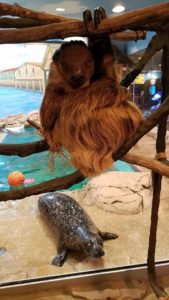 March 18th: Hello my name is Wally! I'm a Linnaeus's two-toed sloth. Usually I am behind the scenes and rarely get to see my aquarium friends. My keepers tell me that the aquarium is closed to the public. So we thought it would be a fun idea to take you on a sort of tour around the aquarium day by day. I'm excited to see all my aquarium friends and learn all about them!
March 18th: Hello my name is Wally! I'm a Linnaeus's two-toed sloth. Usually I am behind the scenes and rarely get to see my aquarium friends. My keepers tell me that the aquarium is closed to the public. So we thought it would be a fun idea to take you on a sort of tour around the aquarium day by day. I'm excited to see all my aquarium friends and learn all about them!
Our first stop was our Harbor Seal exhibit! That's Luseal (or Lucy). My keepers told me that she is an Atlantic harbor seal that stranded herself back in 1991. She was thankfully rescued and rehabilitated at the Marine Mammal Stranding Center in Brigantine, NJ. As you can see Lucy has two different colored eyes. She's that way because she is blind, which is how she came to live here at the aquarium after being at the Stranding Center. Lucy has been at the aquarium since we opened up! She is around 31-32 years old now!
Harbor seals are mammals just like me and you. That means they breathe air, have hair, are warm-blooded, and give birth to live young. Since seals live in the water, they can hold their breath up to 30 minutes! Here at the aquarium Lucy and her tankmate, Noelani, get fed three times a day. They get a mixture of fish and squid.
 March 19th: Hello, Wally here again! Today on Wandering with Wally (that’s what the humans keep calling it), I got to watch some of our divers cleaning the exhibits. The larger exhibits, like the sharks, seals, coral reef, and others, require a diver (or two) to go in and scrub all the walls, rocks, windows, and other things.
March 19th: Hello, Wally here again! Today on Wandering with Wally (that’s what the humans keep calling it), I got to watch some of our divers cleaning the exhibits. The larger exhibits, like the sharks, seals, coral reef, and others, require a diver (or two) to go in and scrub all the walls, rocks, windows, and other things.
Today, the divers were cleaning the Local Fish and Coral Reef Exhibits. These are the first two large exhibits when you walk into the main aquarium. In order to dive, the divers have to be SCUBA certified. They have to wear these special suits to help keep them warm and sometimes even dry! They have a large tank filled with air connected to a regulator, that’s the part that goes into the diver’s mouth, to help them breathe underwater. To help with the diver’s buoyancy, they have to wear a special vest called a buoyancy compensator, or BC. This BC has a bladder in it that can fill or deflate with air to allow the diver to go up and down in the water.
 Diving is a very important part of aquatic animal husbandry. It ensures that the exhibit is clean and healthy for the animals living there. Recently, I’ve noticed my keepers are continually washing and disinfecting their hands. They’ve said there’s something going on that is making people very sick. They tell me by cleaning and disinfecting all the exhibits here, helps all the animals to stay nice and healthy. Washing their hands, and yours, helps you and everyone around you stay nice and healthy, too.
Diving is a very important part of aquatic animal husbandry. It ensures that the exhibit is clean and healthy for the animals living there. Recently, I’ve noticed my keepers are continually washing and disinfecting their hands. They’ve said there’s something going on that is making people very sick. They tell me by cleaning and disinfecting all the exhibits here, helps all the animals to stay nice and healthy. Washing their hands, and yours, helps you and everyone around you stay nice and healthy, too.

March 20th: Who's ready for the next best talk show Between Two Vines?!
 March 21: Hey everyone, Wally again! Today on Wandering with Wally I got to meet my fellow rainforest friends, the parrots and monkeys!
March 21: Hey everyone, Wally again! Today on Wandering with Wally I got to meet my fellow rainforest friends, the parrots and monkeys!
My keepers told me that we have three different types of parrots here. We have a scarlet macaw, rightfully named Scarlett, two blue and gold macaws, named Poncho and Bluebeard, and a Moluccan cockatoo, named Louie. The three macaws can be found in Central and South America (same as me!) and Louie can be found on small islands in Indonesia. Parrots are very smart. They can actually mimic human words 

 Next door, I met our two monkeys, Stinky, a saddleback tamarin, and Pacal, a pygmy marmoset. These guys can also be found in South America. Pacal is the smallest monkey species in the world! He only weighs around 135g (that's less than a can of soda!) Stinky is larger, but still small. Monkeys like to eat different kinds of fruits and veggies, like the birds, and also bugs and something called gum. This isn't the chewing kind though. The gum they like is inside certain trees. They bite into the trees till they can get to it. It's really similar to pancake syrup.
Next door, I met our two monkeys, Stinky, a saddleback tamarin, and Pacal, a pygmy marmoset. These guys can also be found in South America. Pacal is the smallest monkey species in the world! He only weighs around 135g (that's less than a can of soda!) Stinky is larger, but still small. Monkeys like to eat different kinds of fruits and veggies, like the birds, and also bugs and something called gum. This isn't the chewing kind though. The gum they like is inside certain trees. They bite into the trees till they can get to it. It's really similar to pancake syrup.
A lot of people want to have parrots and monkeys as pets. I'm told this is not a good idea. Most parrots can live over 80 years old! They also need constant attention. It’s like living with a 5 year old human child for 80 years 
 Unfortunately, the rainforests we are all from are pretty threatened. We lose hundreds of acres of the rainforest every single day. This is bad for the animals that live there and also for humans. A lot of products humans use on a daily basis come from the rainforest, like coffee, tea, chocolate, fruits, flowers, and tons of other things. A lot of medicines come from the rainforest too! The rainforest also released a lot of oxygen into the atmosphere, which we need to breathe! That's why the rainforest is sometimes called the "lungs of the world".
Unfortunately, the rainforests we are all from are pretty threatened. We lose hundreds of acres of the rainforest every single day. This is bad for the animals that live there and also for humans. A lot of products humans use on a daily basis come from the rainforest, like coffee, tea, chocolate, fruits, flowers, and tons of other things. A lot of medicines come from the rainforest too! The rainforest also released a lot of oxygen into the atmosphere, which we need to breathe! That's why the rainforest is sometimes called the "lungs of the world".
 March 23rd: Sorry I missed you guys yesterday. I was really exhausted and caught up on some
March 23rd: Sorry I missed you guys yesterday. I was really exhausted and caught up on some 
This species of jelly can't chase down their prey. They just spread out all their tentacles, like a net, and as they drift around, catch their food. They like to eat plankton, small mollusks and crustaceans, fish eggs, and larvae.
Their populations have been steadily increasing, including in the Barnegat Bay. This species can out compete many local species, which can severely damage the ecosystem. Plus, they sting!
 March 24th: Wally here! On today's Wandering with Wally I got to meet the sharks! Did you know there's over 300 different species of sharks!! I sure didn't.
March 24th: Wally here! On today's Wandering with Wally I got to meet the sharks! Did you know there's over 300 different species of sharks!! I sure didn't.
The Shark Exhibit here at the aquarium has sandbar sharks, nurse sharks, spotted wobbegongs, a sandtiger shark, and a black tip reef shark. Besides the sharks, there's also different species of fish, like crevalle jacks and blue runners. It is also the largest exhibit at the aquarium, holding 58,000 gallons of water!
Sharks are a type of fish. That means they have gills to help them breathe underwater, fins to help them swim, scales, and are cold-blooded. Shark scales are a little different than regular fish scales though. They're more like modified teeth, called dermal denticles.  Sharks also differ from fish in that they don't have any bones! Their skeleton is made out of something called cartilage. That's the same stuff that makes up your nose and ears.
Sharks also differ from fish in that they don't have any bones! Their skeleton is made out of something called cartilage. That's the same stuff that makes up your nose and ears.
Sharks get a bad rep, mostly cuz of movies. They aren't bad at all though. Since sharks are cold-blooded they don't have to eat as often as us warm-blooded guys. They'll only eat a couple times a week! Sharks also want nothing to do with humans. Humans are more of a threat to sharks, then they are to you. Things like pollution, overfishing, bycatch, and finning effect shark populations.
It's always helpful to recycle properly and use reusable items like water bottles and straws. We only get one planet and need to do what we can to save it.
 March 25th: Hey everyone, Wally here! Today's Wandering with Wally took me to the Barnegat Bay to meet some turtle friends!
March 25th: Hey everyone, Wally here! Today's Wandering with Wally took me to the Barnegat Bay to meet some turtle friends!
These turtles are called Northern diamondback terrapins. They got their name from the diamond pattern on their shells. These guys like to swim in brackish water which is a mixture of fresh and saltwater. Terrapins like to eat small fish, snails, clams, mussels, and other mollusks. They are very strong swimmers. They have webbed feet to help propel them through the water. Terrapins are a type of reptile. They have scales, lay eggs, and are cold-blooded.
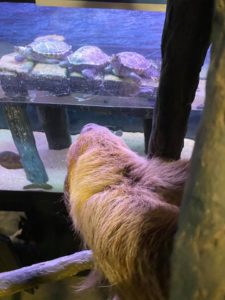 One of our terrapins, Ted, was nice enough to come out and have a conversation with me. Ted got her name from the Turtle Excluder Device. This device stops larger turtles from going into crab traps and getting stuck in them. Turtles have to breathe air, so it won't be good if they get stuck underwater.
One of our terrapins, Ted, was nice enough to come out and have a conversation with me. Ted got her name from the Turtle Excluder Device. This device stops larger turtles from going into crab traps and getting stuck in them. Turtles have to breathe air, so it won't be good if they get stuck underwater.
Terrapins used to be an endangered species, but thanks to organizations like Project Terrapin, they are now of "least concern". The aquarium partners with Project Terrapin. Every year we are given hatchlings that we help raise, then release back into the wild when they are big enough.
Just like with most animals on our planet, pollution is very harmful to our terrapins. We always want to be mindful of our recycling practices and use reusable items as much as possible.
 March 26th: Hello everyone! So today on Wandering with Wally, I decided to take a trip the gift shop and do some shopping!
March 26th: Hello everyone! So today on Wandering with Wally, I decided to take a trip the gift shop and do some shopping!
They just got in a bunch of new sloth stuff!! Just look at that shirt! Do you think it would be a good color on me?
There was also a bunch of sloths on a shelf. I tried to help them climb onto my rack, but they wouldn't climb on. Rude! They were super soft though. Would love to cuddle with them
 My humans said that all this stuff is for sale as soon as the boardwalk opens back up. They weren't sure when that would be, but hopefully it's soon!
My humans said that all this stuff is for sale as soon as the boardwalk opens back up. They weren't sure when that would be, but hopefully it's soon!
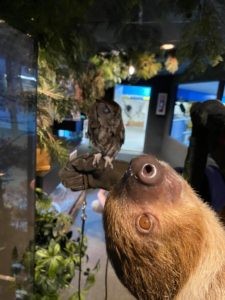 March 27th: After a day of shopping yesterday, it's time to get back to the animals. On today's Wandering with Wally, I got to visit the Pinelands Exhibit and meet Lefty, an Eastern screech owl!
March 27th: After a day of shopping yesterday, it's time to get back to the animals. On today's Wandering with Wally, I got to visit the Pinelands Exhibit and meet Lefty, an Eastern screech owl!
The pinelands
In the Aquarium's Pinelands Exhibit, you can see spotted turtles, 

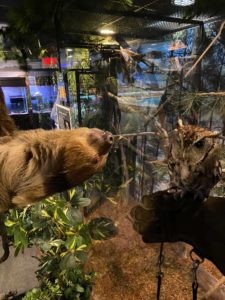 Screech owls are fairly small and one of the more abundant species. There are two "morphs" of Eastern screech owls, the red morph and grey morph. They are birds of prey, no relation to that Harley Quinn and her friends
Screech owls are fairly small and one of the more abundant species. There are two "morphs" of Eastern screech owls, the red morph and grey morph. They are birds of prey, no relation to that Harley Quinn and her friends 
 March 29th: Today on Wandering with Wally, I checked out some local guys. In our New Jersey Neighbors exhibit, there's spotted hake, mummichugs, spider crabs, blue claw crabs, and common seastars.
March 29th: Today on Wandering with Wally, I checked out some local guys. In our New Jersey Neighbors exhibit, there's spotted hake, mummichugs, spider crabs, blue claw crabs, and common seastars.
Spotted hake and mummichugs are a smaller fish species. Spotted hake can get up to 16 inches, while mummichugs max out around 4 inches. Hake feed on crustaceans, fish, and squid. Mummichugs like to eat fish eggs, insect larvae, ellgrasses, and smaller fish. They will even eat other mummichugs!
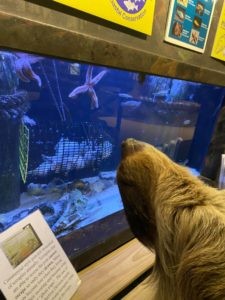 Spider crabs are scavengers, eating whatever they can find. They may look scary, but it's all for show. They have weak claws and are pretty slow moving. On the other hand, blue claw crabs are pretty aggressive. They have very powerful claws and their back legs are modified into little paddles. That allows to swim rather quickly in the water. I hear they also have a baseball team named after them.
Spider crabs are scavengers, eating whatever they can find. They may look scary, but it's all for show. They have weak claws and are pretty slow moving. On the other hand, blue claw crabs are pretty aggressive. They have very powerful claws and their back legs are modified into little paddles. That allows to swim rather quickly in the water. I hear they also have a baseball team named after them.
Common seastars are, wait for it, pretty common (haha) in our area. They have 5 arms surrounding a circular disk. Underneath their arms, they have hundreds of tiny tube feet that help them move around and stick to things. Seastars also have a superpower! If they lose one of their arms, they can grow it back! That's called regeneration. Pretty cool.
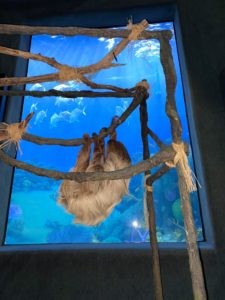 March 30th: Today on Wandering with Wally, I got to visit our Coral Reef Exhibit! This is one of the larger exhibits on the first floor, next to the shark exhibit.
March 30th: Today on Wandering with Wally, I got to visit our Coral Reef Exhibit! This is one of the larger exhibits on the first floor, next to the shark exhibit.
Even though coral doesn't move much, it is actually a type of animal, not a plant. Corals are actually small, sac-like animals called polyps. They excrete an exoskeleton at their base and after many generations, create the coral reefs that we see. Each species of polyps can create a different exoskeleton. When stressed out or in high water temperatures, there can be bleaching events. This doesn't kill the corals right away, but they will eventually starve.
The Aquarium is now part of the Florida Reef Tract project. There is a disease, Stony Coral Tissue Loss  Disease, effecting many corals in the Florida Keys and Caribbean. Along with governments agencies, scientists, aquariums, and other institutions, we are trying to determine the cause of this disease and how to prevent it. The FRT's strategy is to have institutions house and grow healthy corals, eventually reintroducing them to the wild.
Disease, effecting many corals in the Florida Keys and Caribbean. Along with governments agencies, scientists, aquariums, and other institutions, we are trying to determine the cause of this disease and how to prevent it. The FRT's strategy is to have institutions house and grow healthy corals, eventually reintroducing them to the wild.
There are things we can do in our everyday lives to help corals and other marine life out. Things like conserving water, recycling properly, using sunscreen that isn't harmful to marine life, and practicing safe boating
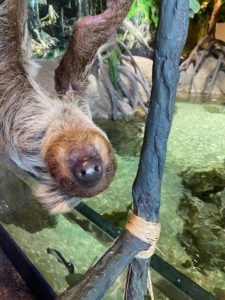 April 1st: I'm back! Hope you all enjoyed hanging with Lilo yesterday. She was nice enough to give back my time with all of you. Today, I got to hang (pun intended) with some cool rays in our Mangrove Exhibit.
April 1st: I'm back! Hope you all enjoyed hanging with Lilo yesterday. She was nice enough to give back my time with all of you. Today, I got to hang (pun intended) with some cool rays in our Mangrove Exhibit.
In this exhibit there's a bunch of different rays and some sharks too. We have fiddler rays, yellow rays, Atlantic rays, round rays, cat sharks, epaulette sharks, and bamboo sharks. This exhibit is also a touch pool! Normally when we're open, you'll get the chance to touch these rays. But you can only use two fingers 
Mangrove forests are pretty cool. They're the only type of tree that can tolerate salt water! 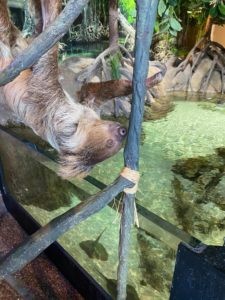 Mangroves like to grow on the coasts of many tropical and subtropical countries. Most of these forests can be found in Indonesia, all the way on the other side of our planet.
Mangroves like to grow on the coasts of many tropical and subtropical countries. Most of these forests can be found in Indonesia, all the way on the other side of our planet.
Mangroves are home to hundreds of animals. Tons of different species of birds, mammals, and reptiles can found in them. Including me!! Sloths will go into mangroves to find some food or for a quick drink and even for a little swim. The roots of the mangroves also provide a nursery for many different fish and shark species. Crabs, shellfish, and tons of other animals can be found there as well.
Mangroves are vital to surrounding human populations. Their dense, impenetrable roots provide protection against storm surges and rising seas. It is important to help protect these unique ecosystems.
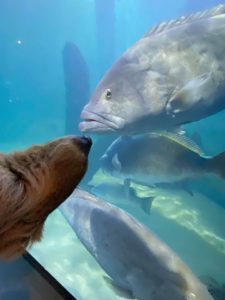 April 2nd: Hey all!! Wally here. Today I made a new friend! That's a gag grouper. The gag groupers in the Local Exhibit love to look at everyone. Almost like they're having a staring contest with you! I think they miss all the humans looking at them, so I decided to have a little stare down with them.
April 2nd: Hey all!! Wally here. Today I made a new friend! That's a gag grouper. The gag groupers in the Local Exhibit love to look at everyone. Almost like they're having a staring contest with you! I think they miss all the humans looking at them, so I decided to have a little stare down with them.
Gag groupers can be found all along the East Coast of the US, but are more abundant south of North Carolina and into the Gulf of Mexico. They can get over 3 feet long and weigh more than 50lbs! These fish like to eat crabs, shrimp, squid, and other fish.
The gag groupers at the aquarium live with black drums, sea robins, American eels, permit, and our Kemp's Ridley sea turtle, Ace! Ace was napping when I went for my visit. Lucky. Maybe we'll get to meet each other another day.
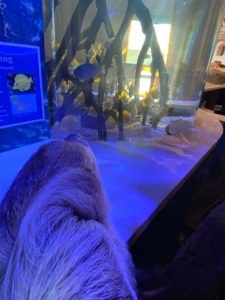 April 3rd: Hey everyone! Wally here. Today I got to hang out with some yellow tangs. These brightly colored fish are the first things you'll see when you visit the aquarium. They love gathering in a big group in front of the glass to welcome all our guests.
April 3rd: Hey everyone! Wally here. Today I got to hang out with some yellow tangs. These brightly colored fish are the first things you'll see when you visit the aquarium. They love gathering in a big group in front of the glass to welcome all our guests.
Yellow tangs are mostly found in shallow reefs in the Pacific Ocean, in-between Hawaii and Japan. They're mostly herbivores, eating algae and other marine plant material. They'll even follow sea turtles around and eat the algae off their shells! Almost like a drive-in car wash!
Yellow tangs are protected in almost 70% of their natural range, even thought they are listed as "Least Concern". This has been mostly due to harvesting for the pet trade. 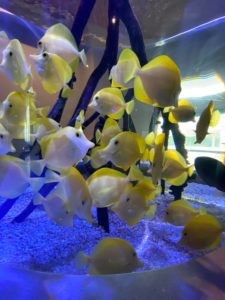 They are now able to be successfully bred in human care, in an effort to preserve their wild populations. It is always important to do your research before getting any kind of pet. Some animals need very unique care that might be difficult to do in your home.
They are now able to be successfully bred in human care, in an effort to preserve their wild populations. It is always important to do your research before getting any kind of pet. Some animals need very unique care that might be difficult to do in your home.
 April 4th: Wally here! Today I got to visit some clownfish! These little guys are next to the boardwalk, across from the larger Coral Reef and Local Exhibits.
April 4th: Wally here! Today I got to visit some clownfish! These little guys are next to the boardwalk, across from the larger Coral Reef and Local Exhibits.
The clownfish in here are common clownfish. They all were actually hatched right here at the aquarium! They're around 4 years old now.
This species of clownfish are mostly found in the eastern Indian Ocean and Western Pacific Ocean. They can also be found around northern Australia, southeast Asia, and Japan. They can get around 4 inches long and vary in color.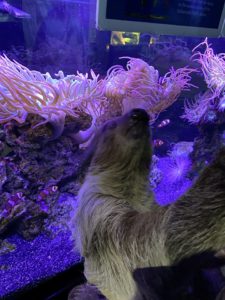 Most of the time they look like the "classic" clownfish colors, like Nemo and Marlin, but they can also be black in color with white stripes.
Most of the time they look like the "classic" clownfish colors, like Nemo and Marlin, but they can also be black in color with white stripes.
These clownfish can be very territorial and dependent of their sea anemone. The two of them have a symbiotic relationship, which means they both benefit from each other. The anemone offer shelter and protection for the clownfish, while the clownfish can provide food for the anemone. You might see clownfish "fanning" the anemone. This will allow the anemone to eat any kind of parasites off the clownfish. Since clownfish are very protective of their anemone, this keeps other fish that would eat anemones away from them
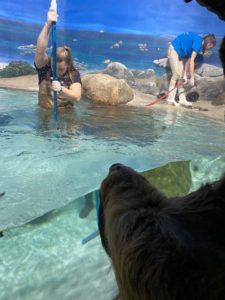 April 5th: Hey everyone! Wally here again. Today I watched some of our hardworking keepers cleaning the penguin exhibit.
April 5th: Hey everyone! Wally here again. Today I watched some of our hardworking keepers cleaning the penguin exhibit.
Can you believe that penguins 
Besides scrubbing the exhibit floor, the pool also needs to have water changes and scrubbed every week too. Penguins sure are a lot of work (and pretty smelly too!)
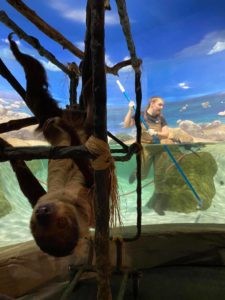 My humans said that they're gonna be doing things a little differently for the next couple of weeks. They are gonna do special things each day for this thing they keep calling "social media". I'll get to hang out (pun intended) with you guys on Wednesdays now. They're calling it "Wally Wednesdays". Aren't they so clever
My humans said that they're gonna be doing things a little differently for the next couple of weeks. They are gonna do special things each day for this thing they keep calling "social media". I'll get to hang out (pun intended) with you guys on Wednesdays now. They're calling it "Wally Wednesdays". Aren't they so clever 
 April 8th: Today is Draw A Bird Day Wally asked for Scarlet's help. He did some research, grabbed his pen and went to work! Scarlet was critiquing his finished work
April 8th: Today is Draw A Bird Day Wally asked for Scarlet's help. He did some research, grabbed his pen and went to work! Scarlet was critiquing his finished work
 April 11th: Wally decided to have some fun today and dye some eggs (and try to steal all the candy for himself!)
April 11th: Wally decided to have some fun today and dye some eggs (and try to steal all the candy for himself!)
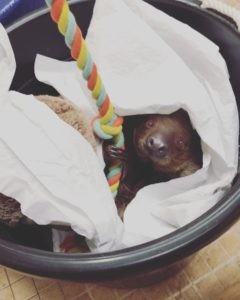 April 15th: But it's so cozy in here!
April 15th: But it's so cozy in here!
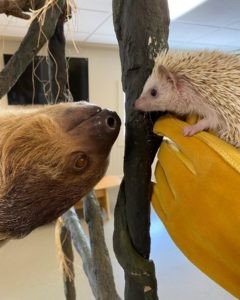 April 15th: Wally got to meet our newest addition to the Jenkinson's Aquarium family, Spike! He joined the fam to be a part of our animal ambassadors for some of our education programs and summer camp. Seems like the two of them got off pretty well.
April 15th: Wally got to meet our newest addition to the Jenkinson's Aquarium family, Spike! He joined the fam to be a part of our animal ambassadors for some of our education programs and summer camp. Seems like the two of them got off pretty well.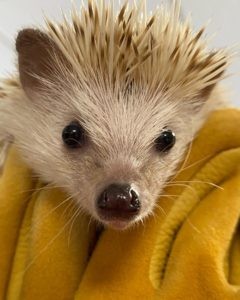
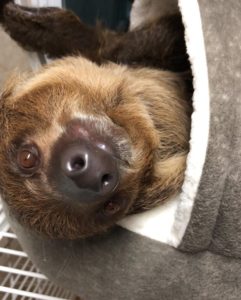 April 23rd: Happy Gotcha Day to our Wally!! Two years ago today, he joined the JA family.
April 23rd: Happy Gotcha Day to our Wally!! Two years ago today, he joined the JA family.
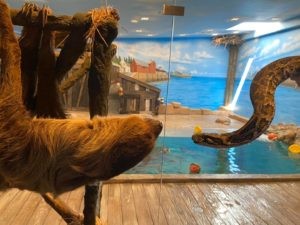 April 29th: Hey everyone! It's#wallywednesday
April 29th: Hey everyone! It's#wallywednesday
Today I got to hang out with Eddie, the Burmese python! He has been here at the aquarium for a long time. Pretty much since we opened in 1991!
Burmese pythons are native to southeast Asia. They can be found in grasslands, marshes, jungles, rocky foothills, river valleys, and woodlands.
These snakes, just like all others, are carnivorous. They'll eat pretty much anything that comes their way. Pythons are constrictors. They do not possess venom glands to kill their prey. Instead they wrap around their prey and squeeze them.
 Burmese pythons are considered "threatened" due to habitat loss, world leather trade, and the pet trade. These snakes can grow very quickly and get very large (usually around 6-7ft, but in some cases up to 15ft long!)
Burmese pythons are considered "threatened" due to habitat loss, world leather trade, and the pet trade. These snakes can grow very quickly and get very large (usually around 6-7ft, but in some cases up to 15ft long!)
Because of their large size and irresponsible pet owners not doing their research beforehand, there is a large invasive population in Florida. The pythons are out competing many native species and causing a huge decline in native species populations.
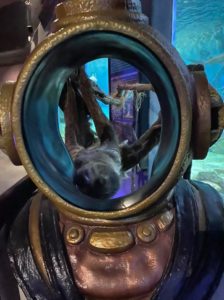 April 30th: Throwback to Wally wanting his picture in the diver photo op. Anyone got pictures in this?
April 30th: Throwback to Wally wanting his picture in the diver photo op. Anyone got pictures in this?



